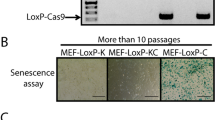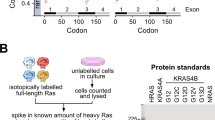Abstract
An important aspect of multi-step tumorigenesis is the mutational activation of genes of the RAS family, particularly in sporadic cancers of the pancreas, colon, lung and myeloid system1. RAS genes encode small GTP-binding proteins that affect gene expression in a global way by acting as major switches in signal transduction processes, coupling extracellular signals with transcription factors2,3,4. Oncogenic forms of RAS are locked in their active state and transduce signals essential for transformation, angiogenesis, invasion and metastasis via downstream pathways involving the RAF/MEK/ERK cascade of cytoplasmic kinases, the small GTP-binding proteins RAC and RHO, phosphatidylinositol 3-kinase and others5,6. We have used subtractive suppression hybridization (SSH), a PCR-based cDNA subtraction technique7, to contrast differential gene expression profiles in immortalized, non-tumorigenic rat embryo fibroblasts and in HRAS- transformed cells. Sequence and expression analysis of more than 1,200 subtracted cDNA fragments revealed transcriptional stimulation or repression of 104 ESTs, 45 novel sequences and 244 known genes in HRAS- transformed cells compared with normal cells. Furthermore, we identified common and distinct targets in cells transformed by mutant HRAS, KRAS and NRAS, as well as 61 putative target genes controlled by the RAF/MEK/ERK pathway in reverted cells treated with the MEK-specific inhibitor PD 98059.
This is a preview of subscription content, access via your institution
Access options
Subscribe to this journal
Receive 12 print issues and online access
$209.00 per year
only $17.42 per issue
Buy this article
- Purchase on Springer Link
- Instant access to full article PDF
Prices may be subject to local taxes which are calculated during checkout



Similar content being viewed by others
References
Bos, J.L. Ras oncogenes in human cancer: a review. Cancer Res. 49, 4682–4689 (1989).
Barbacid, M. Ras genes. Annu. Rev. Biochem. 56, 779– 827 (1987).
Abdellatif, M., MacLellan, W.R. & Schneider, M.D. p21 Ras as a governor of global gene expression. J. Biol. Chem. 269, 15423–15426 (1994).
Malumbres, M. & Pellicer, A. Ras pathways to cell cycle control and cell transformation. Front. Biosci. 3, 887–912 (1998).
Khosravi, F.R., Campbell, S., Rossman, K.L. & Der, C.J. Increasing complexity of Ras signal transduction: involvement of Rho family proteins. Adv. Cancer Res. 72, 57– 107 (1998).
Downward, J. in G Proteins, Cytoskeleton and Cancer (eds Maruta, H. & Kohama, K.) 171–183 (R.G. Landes, Austin, 1998).
Diatchenko, L. et al. Suppression subtractive hybridization: a method for generating differentially regulated or tssue-specific cDNA probes and libraries. Proc. Natl Acad. Sci. USA 93, 6025– 6030 (1996).
Groudine, M. & Weintraub, H. Activation of cellular genes by avian RNA tumor viruses. Proc. Natl Acad. Sci. USA 77, 5351–5354 (1980).
Augenlicht, L.H. et al. Expression of cloned sequences in biopsies of human colonic tissue and in colonic carcinoma cells induced to differentiate in vitro. Cancer Res. 47, 6017–6021 (1987).
Zhang, L. et al. Gene expression profiles in normal and cancer cells. Science 276, 1268–1271 ( 1997).
Chang, D.D., Park, N.H., Denny, C.T., Nelson, S.F. & Pe, M. Characterization of transformation related genes in oral cancer cells. Oncogene 16, 1921– 1930 (1998).
von Stein, O.D., Thies, W.G. & Hofmann, M. A high throughput screening for rarely transcribed differentially expressed genes. Nucleic Acids Res. 25, 2598–2602 (1997).
Denko, N.C., Giaccia, A.J., Stringer, J.R. & Stambrook, P.J. The human Ha-ras oncogene induces genomic instability in murine fibroblasts within one cell cycle. Proc. Natl Acad. Sci. USA 91 , 5124–5128 (1994).
Denko, N., Stringer, J., Wani, M. & Stambrook, P. Mitotic and post mitotic consequences of genomic instability induced by oncogenic Ha-ras. Somat. Cell Mol. Genet. 21, 241– 253 (1995).
Quade, K. Transformation of mammalian cells by avian myelocytomatosis virus and avian erythroblastosis virus. Virology 98, 461 –465 (1979).
Griegel, S., Traub, O., Willecke, K. & Schäfer, R. Suppression and re-expression of transformed phenotype in hybrids of Ha-ras1 transformed Rat-1 cells and early passage rat embryo fibroblasts. Int. J. Cancer 38, 697–705 ( 1986).
Sers, C. et al. Growth-inhibitory activity and downregulation of the class II tumor-suppressor gene H-rev107 in tumor cell lines and experimental tumors. J. Cell Biol. 136, 935– 944 (1997).
Sager, R. Expression genetics in cancer: shifting the focus from DNA to RNA. Proc. Natl Acad. Sci. USA 94, 952– 955 (1997).
Dudley, D.T., Pang, L., Decker, S.J., Bridges, A.J. & Saltiel, A.R. A synthetic inhibitor of the mitogen-activated protein kinase cascade. Proc. Natl Acad. Sci. USA 92, 7686–7689 (1995).
Adams, A.T. & Auersperg, N. A cell line, ROSE 199, derived from normal rat ovarian surface epithelium. Exp. Cell Biol. 53, 181–188 (1985).
Liu, H.S., Scrable, H., Villaret, D.B., Lieberman, M.A. & Stambrook, P.J. Control of Ha-ras-mediated mammalian cell transformation by Escherichia coli regulatory elements. Cancer Res. 52, 983–989 ( 1992).
Patton, S.E. et al. Activation of the ras-mitogen-activated protein kinase pathway and phosphorylation of ets-2 at position threonine 72 in human ovarian cancer cell lines. Cancer Res. 58, 2253– 2259 (1998).
Clark, G.J. & Der, C.J. Aberrant function of the Ras signal transduction pathway in human breast cancer. Breast Cancer Res. Treat. 35, 133–144 ( 1995).
DeClue, J.E. et al. Abnormal regulation of mammalian p21(ras) contributes to malignant tumor growth in Vonrecklinghausen (Type-1) neurofibromatosis. Cell 69, 265–273 ( 1992).
Puil, L. et al. BCR-ABL oncoproteins bind directly to activators of the Ras signalling pathway. EMBO J. 13, 764– 773 (1994).
Jung, J.U. & Desrosiers, R.C. Association of the viral oncoprotein STP-C488 with cellular ras. Mol. Cell. Biol. 15, 6506– 6512 (1995).
Fambrough, D., McClure, K., Kazlauskas, A. & Lander, E.S. Diverse signaling pathways activated by growth factor receptors induce broadly overlapping, rather than independent, sets of genes. Cell 97, 727–741 (1999).
Iyer, V.R. et al. The transcriptional program in the response of human fibroblasts to serum. Science 283, 83– 87 (1999).
Husmann, K. et al. Transcriptional and translational downregulation of H-REV107, a class II tumour suppressor gene located on human chromosome 11q11–12. Oncogene 17, 1305–1312 (1998).
Souyri, M. et al. Biological effects of a murine retrovirus carrying an activated N-ras gene of human origin. Virology 158, 69– 78 (1987).
Chomczynski, P. & Sacchi, N. Single-step method of RNA isolation by acid guanidinium thiocyanate-phenol-chloroform extraction. Anal. Biochem. 162, 156– 159 (1987).
Acknowledgements
We thank S. Petermann, J. Keil and K. Skultety for technical assistance; R. Brinckmann for sequencing; C. Schlüns for computing; F. Leenders and F. Theuring for help with phospho-image analysis; and M. Dietel for generous support. Our work was supported by Deutsche Krebshilfe (grant 10-332-Schä I to R.S.), Krebsliga des Kantons Zürich (grant to R.S.), Studienstiftung des Deutschen Volkes and Forschungsförderung der Charité (to J.Z.), and Berliner Krebsgesellschaft (grant to R.S.).
Author information
Authors and Affiliations
Corresponding author
Supplementary information
Rights and permissions
About this article
Cite this article
Zuber, J., Tchernitsa, O., Hinzmann, B. et al. A genome-wide survey of RAS transformation targets. Nat Genet 24, 144–152 (2000). https://doi.org/10.1038/72799
Received:
Accepted:
Issue Date:
DOI: https://doi.org/10.1038/72799
This article is cited by
-
Design of amino acid- and carbohydrate-based anticancer drugs to inhibit polymerase η
Scientific Reports (2022)
-
Reduced replication origin licensing selectively kills KRAS-mutant colorectal cancer cells via mitotic catastrophe
Cell Death & Disease (2020)
-
RAS-Mutationen in der molekularen Tumorkonferenz
Der Pathologe (2019)
-
Activation of KRAS promotes the mesenchymal features of basal-type breast cancer
Experimental & Molecular Medicine (2015)
-
Transcriptomic analysis of differentially expressed genes in the Ras1CA-overexpressed and wildtype posterior silk glands
BMC Genomics (2014)



